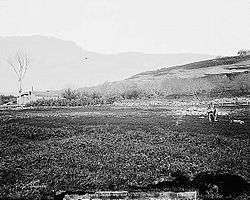Tel Dothan
Dothan (Hebrew: דֹתָן) (also Dotan) was a location mentioned twice in the bible. It has been identified with Tel Dothan (Arabic: تل دوثان), also known as Tel al-Hafireh, located adjacent to the Palestinian town of Bir al-Basha,[1] and ten kilometers (driving distance) southwest of Jenin, near Dotan Junction of Route 60.[2][3][4]


History

Dothan is first mentioned in the Hebrew Bible (Genesis 37:17) in connection with the history of Joseph, as the place in which the sons of Jacob Israel) sons had moved their sheep and, at the suggestion of Judah, the brothers sold Joseph to the Ishmaelite merchants (Gen. 37:17). It later appears as the residence of Elisha (2 Kings 6:13) and the scene of a vision of chariots and horses of fire surrounding the mountain on which the city stood.[5] The city then served as an Israelite administrative centre, and archaeology has discovered a large complex and Hebrew inscriptions from the site.[6][7]
The Israeli settlement of Mevo Dotan (lit. Approach to Dothan) is named for the city, as is Dothan, Alabama.
Modern discovery
Tel Dothan
Charles William Meredith van de Velde visited the site in 1851, and was considered the first modern traveller to visit it.[8] He described the discovery in his 1854 book:[9]
...I saw a huge tell at the distance of only a few hundred yards from our way, covered over with ruins, and the fragment of an ancient aqueduct, that had been supported on arches. I asked Abu Monsur the name of the tell, and the answer was, "Haida Dothan" (that is, Dothan). "Dothan," I asked, "Dothan?" "Nahm; Dothan, Dothan, Dothan!" exclaimed the testy old shech, as if hurt at my not believing him at the instant. My object in reiterating the question was to get him to repeat the name; for the discovery of Dothan was a very special circumstance, with respect to which I was anxious to assure myself, by having the name properly pronounced.
van de Velde's visit had taken place a few days before Edward Robinson's;[4] Robinson credited van ve Velde with the discovery.[10]
Eusebius places Dothan 12 miles to the north of Sebaste; broadly consistent with the modern location.[11]
Tel Dothan
Crusader period
Castellum Beleismum (Latin) or Chastiau St Job (medieval French)[12] was the Frankish name of a tower built by the Crusaders on the ancient tell in 1156 and given to the Hospitallers in 1187.
References
- Shahin, Mariam (2005). Palestine: A Guide. Interlink Books. ISBN 978-1-56656-557-8.
Tel al-Hafireh (Tel Dothan) Tel al-Hafireh is an archeological site that lies 6 kilometers south of Jenin, close to the village of Bir al-Basha.
- Daniel M. Master; John Monson. "Tel Dothan 2002 Overview". Harvard University: Faculty of arts and Sciences. Archived from the original on 2010-07-04. Retrieved 2011-07-24.
- "Tel Dothan (photo and map)". panoramio.com. Retrieved 2011-07-24.
- Robinson, Edward, Biblical Researches in Palestine and the Adjacent Regions, second edition, page 122; "footnote 434: We learned afterwards from Mr Van de Velde, that he too had unexpectedly lighted upon Dothan a few days earlier."
- 2 Kings 6:17
- Master; Monson; Lass; Peirce (2005). Dothan I: Remains from the Tell (1953-1964). Winona Lake: Eisenbrauns.
- Miglio (2014). "Epigraphic Artifacts from Tell Dothan". BASOR.
- Bonar, Horatius (1858). The Land of Promise: Notes of a Spring-journey from Beersheba to Sidon. James Nisbet & Company. p. 384.
See Van de Velde's Syria and Palestine vol. i. p. 364. That traveller may claim the discovery of the site. He visited the spot, whereas E Robinson, like ourselves, only had it pointed out at a distance
- Velde, van de, Charles William Meredith (1854). Narrative of a journey through Syria and Palestine in 1851 and 1852. 1. William Blackwood and son. p. 364.
- Master, Daniel M.; Larsen, Timothy; Monson, John; Egon H. E. Lass; George A. Pierce (2005). Dothan: Remains from the Tell (1953-1964). Eisenbrauns. p. 7. ISBN 978-1-57506-115-3.
- Eusebius of Caesarea, Onomasticon (1971), Notes edited by. C. Umhau Wolf under "Merran", accessed 27 December 2017
- Ellenblum, Ronnie (2007). Crusader Castles and Modern Histories. Cambridge University Press. p. 173. ISBN 9781139462556. Retrieved 7 June 2020.
Bibliography
- Conder, C.R. (1878). Tent work in Palestine. A record of discovery and adventure. 1. Internet.archive (from Harvard collection). (pp. 116 -117)
- Conder, C.R.; Kitchener, H.H. (1882). The Survey of Western Palestine: Memoirs of the Topography, Orography, Hydrography, and Archaeology. 2. London: Committee of the Palestine Exploration Fund. (p. 215)
- Guérin, V. (1875). Description Géographique Historique et Archéologique de la Palestine (in French). 2: Samarie, pt. 2. Paris: L'Imprimerie Nationale. (pp. 219-222)
- Maundrell, H. (1703). A Journey from Aleppo to Jerusalem: At Easter, A. D. 1697. Oxford: Printed at the Theatre. (p. 57)
- Palmer, E.H. (1881). The Survey of Western Palestine: Arabic and English Name Lists Collected During the Survey by Lieutenants Conder and Kitchener, R. E. Transliterated and Explained by E.H. Palmer. Committee of the Palestine Exploration Fund. (p. 194)
- Robinson, E.; Smith, E. (1841). Biblical Researches in Palestine, Mount Sinai and Arabia Petraea: A Journal of Travels in the year 1838. 3. Boston: Crocker & Brewster. (pp. 316 - 317)
- Zertal, A. (2004). The Manasseh Hill Country Survey. 1. Boston: BRILL. ISBN 9004137564. (pp. 149-150)
External links
- Survey of Western Palestine, Map 11: IAA, Wikimedia commons
- Dothan: Remains from the tel (1953-1964), Daniel M. Master